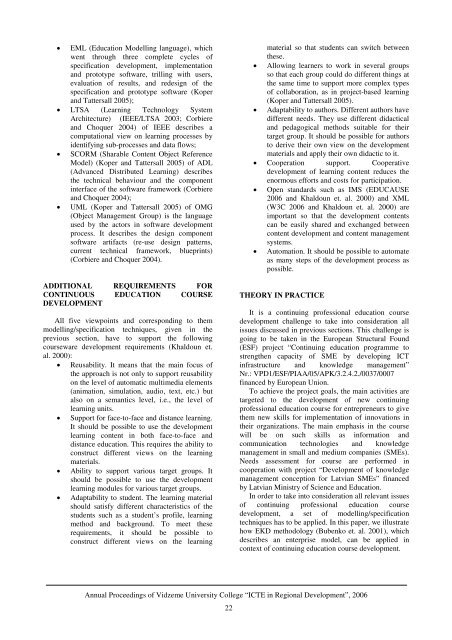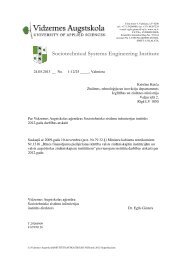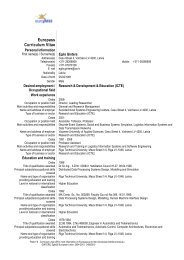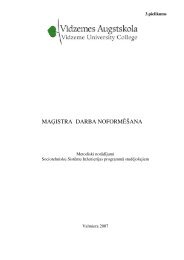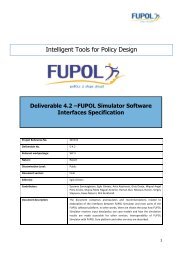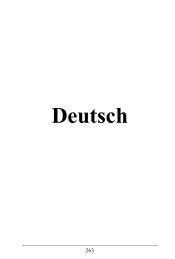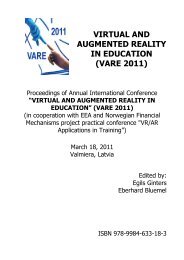Proceedings in pdf format. - Sociotechnical Systems Engineering ...
Proceedings in pdf format. - Sociotechnical Systems Engineering ...
Proceedings in pdf format. - Sociotechnical Systems Engineering ...
Create successful ePaper yourself
Turn your PDF publications into a flip-book with our unique Google optimized e-Paper software.
• EML (Education Modell<strong>in</strong>g language), whichwent through three complete cycles ofspecification development, implementationand prototype software, trill<strong>in</strong>g with users,evaluation of results, and redesign of thespecification and prototype software (Koperand Tattersall 2005);• LTSA (Learn<strong>in</strong>g Technology SystemArchitecture) (IEEE/LTSA 2003; Corbiereand Choquer 2004) of IEEE describes acomputational view on learn<strong>in</strong>g processes byidentify<strong>in</strong>g sub-processes and data flows;• SCORM (Sharable Content Object ReferenceModel) (Koper and Tattersall 2005) of ADL(Advanced Distributed Learn<strong>in</strong>g) describesthe technical behaviour and the component<strong>in</strong>terface of the software framework (Corbiereand Choquer 2004);• UML (Koper and Tattersall 2005) of OMG(Object Management Group) is the languageused by the actors <strong>in</strong> software developmentprocess. It describes the design componentsoftware artifacts (re-use design patterns,current technical framework, bluepr<strong>in</strong>ts)(Corbiere and Choquer 2004).ADDITIONAL REQUIREMENTS FORCONTINUOUS EDUCATION COURSEDEVELOPMENTAll five viewpo<strong>in</strong>ts and correspond<strong>in</strong>g to themmodell<strong>in</strong>g/specification techniques, given <strong>in</strong> theprevious section, have to support the follow<strong>in</strong>gcourseware development requirements (Khaldoun et.al. 2000):• Reusability. It means that the ma<strong>in</strong> focus ofthe approach is not only to support reusabilityon the level of automatic multimedia elements(animation, simulation, audio, text, etc.) butalso on a semantics level, i.e., the level oflearn<strong>in</strong>g units.• Support for face-to-face and distance learn<strong>in</strong>g.It should be possible to use the developmentlearn<strong>in</strong>g content <strong>in</strong> both face-to-face anddistance education. This requires the ability toconstruct different views on the learn<strong>in</strong>gmaterials.• Ability to support various target groups. Itshould be possible to use the developmentlearn<strong>in</strong>g modules for various target groups.• Adaptability to student. The learn<strong>in</strong>g materialshould satisfy different characteristics of thestudents such as a student’s profile, learn<strong>in</strong>gmethod and background. To meet theserequirements, it should be possible toconstruct different views on the learn<strong>in</strong>gmaterial so that students can switch betweenthese.• Allow<strong>in</strong>g learners to work <strong>in</strong> several groupsso that each group could do different th<strong>in</strong>gs atthe same time to support more complex typesof collaboration, as <strong>in</strong> project-based learn<strong>in</strong>g(Koper and Tattersall 2005).• Adaptability to authors. Different authors havedifferent needs. They use different didacticaland pedagogical methods suitable for theirtarget group. It should be possible for authorsto derive their own view on the developmentmaterials and apply their own didactic to it.• Cooperation support. Cooperativedevelopment of learn<strong>in</strong>g content reduces theenormous efforts and costs for participation.• Open standards such as IMS (EDUCAUSE2006 and Khaldoun et. al. 2000) and XML(W3C 2006 and Khaldoun et. al. 2000) areimportant so that the development contentscan be easily shared and exchanged betweencontent development and content managementsystems.• Automation. It should be possible to automateas many steps of the development process aspossible.THEORY IN PRACTICEIt is a cont<strong>in</strong>u<strong>in</strong>g professional education coursedevelopment challenge to take <strong>in</strong>to consideration allissues discussed <strong>in</strong> previous sections. This challenge isgo<strong>in</strong>g to be taken <strong>in</strong> the European Structural Found(ESF) project “Cont<strong>in</strong>u<strong>in</strong>g education programme tostrengthen capacity of SME by develop<strong>in</strong>g ICT<strong>in</strong>frastructure and knowledge management”Nr.: VPD1/ESF/PIAA/05/APK/3.2.4.2./0037/0007f<strong>in</strong>anced by European Union.To achieve the project goals, the ma<strong>in</strong> activities aretargeted to the development of new cont<strong>in</strong>u<strong>in</strong>gprofessional education course for entrepreneurs to givethem new skills for implementation of <strong>in</strong>novations <strong>in</strong>their organizations. The ma<strong>in</strong> emphasis <strong>in</strong> the coursewill be on such skills as <strong>in</strong><strong>format</strong>ion andcommunication technologies and knowledgemanagement <strong>in</strong> small and medium companies (SMEs).Needs assessment for course are performed <strong>in</strong>cooperation with project “Development of knowledgemanagement conception for Latvian SMEs” f<strong>in</strong>ancedby Latvian M<strong>in</strong>istry of Science and Education.In order to take <strong>in</strong>to consideration all relevant issuesof cont<strong>in</strong>u<strong>in</strong>g professional education coursedevelopment, a set of modell<strong>in</strong>g/specificationtechniques has to be applied. In this paper, we illustratehow EKD methodology (Bubenko et. al. 2001), whichdescribes an enterprise model, can be applied <strong>in</strong>context of cont<strong>in</strong>u<strong>in</strong>g education course development.Annual <strong>Proceed<strong>in</strong>gs</strong> of Vidzeme University College “ICTE <strong>in</strong> Regional Development”, 200622


